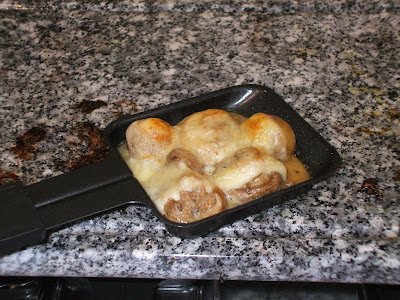Blue cheese is a family or type of cheese, not a specific cheese. When I see a container of blue cheese crumbles, I have to wonder what kind of blue cheese is actually in there or did they just let some other cheese get moldy. There are many different types of blue cheeses. Some are made from cow's milk, sheep's milk, a combination of milks, and the use of goat's milk is becoming more popular. There are blue cheeses with natural rinds, foil wrapped blues without rinds, and blue cheese with bloomy rinds. There is even one blue cheese with a black wax rind called Roaring 40's from King Island Dairy is Australia. There are soft creamy blues, crumbly blues, and drier styles of blue cheese. Some blues are mild like Regina and really abrasive blues like Tilston Point. There is even a blue cheese that is cold smoked over hazelnut shells, Smokey Blue which is made by the blue cheese masters at Rouge Creamery in Oregon.

This is an up close look at Verde Capra which is an Italian goat's milk blue
There are a couple of different ways to make blue cheese, the first few steps are the same as any other cheese making process. The big difference is the addition of a mold culture. You can add the mold to the milk when making the cheese or you can spray on the mold after the wheel of cheese is made. Either way, the cheese must be pierced to create air channels to promote the growth of the mold. Air is necessary for the creation of mold because mold is alive. Sometimes these air channels are made by piercing the cheese with wheat stalks but more often stainless steal needles are used. When a wheel of blue is cut into for the first time, the green streaks of mold become more blue due to the exposure of air. I love to watch this magic happen.
One of the most famous styles of blue cheese is Roquefort which is made from raw sheep's milk. When you eat Roquefort, you are eating history. This cheese has been made using the same methods, same molds, and aged in the same location for centuries. No one is exactly sure how Roquefort was first made but there has been speculation. A shepherd sits down at the mouth of a cave to enjoy his lunch of bread and cheese when a beautiful woman saunters by and distracts him from his lunch. They run off to romp and by the time the shepherd returns, his bread is moldy and that mold has infected his cheese. This does not deter the man from enjoying his cheese and he finds the taste of the cheese to be improved by the mold.
The enjoyment of blue cheese is very much like wine appreciation, you have to develop your palette. The more blue cheese you eat, the more you will enjoy this moldy cheese and the more adventurous your tastes will become. If you are not a fan of blue cheese or find them intimidating, try a milder sweeter blue like Gorgonzola Dolce. Another way to enhance your blue cheese palette is to pair the cheese with the right beverage or food. Blue cheese will pair well with sweeter wines and ports. Port and Stilton is a classic wine and cheese combination. Blue cheese is great melted on a steak or burger and makes a wonderful addition to sauces and salad dressings. Try a bit of blue cheese with a sweeter bread like raisin walnut bread or Raincoast Crisps. You can also drizzle your blue in honey or Saba or with pears and walnuts.








































